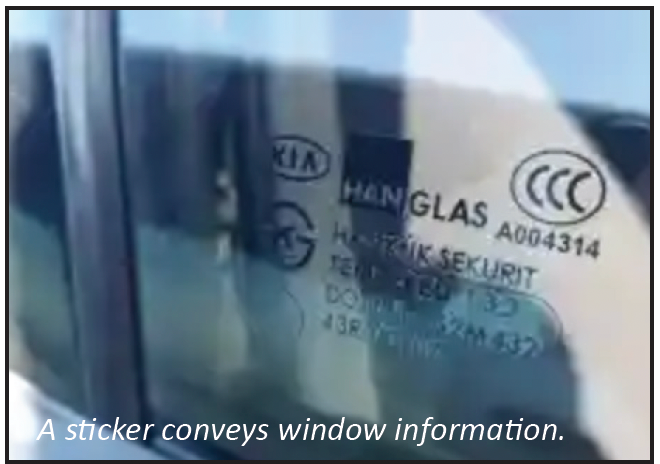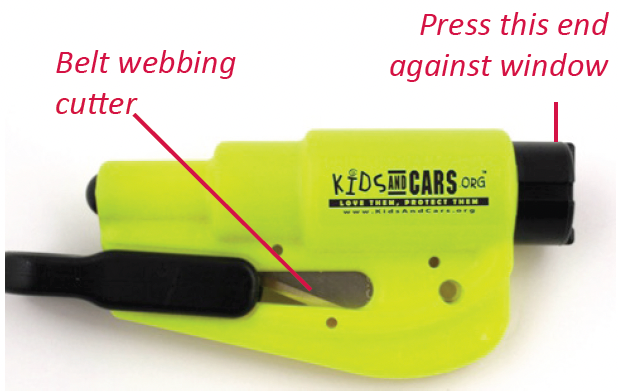In an emergency, know these right (and wrong) ways to purposely shatter automotive glass
Most CPSTs have noticed that TV shows rarely depict CPS best practices. An episode from ABC’s Modern Family provides a good example when a dad frantically runs toward his vehicle intending to break a window with a garbage can to free his infant daughter locked inside.
While the scene succeeds in conveying an appropriate level of urgency when a child is trapped in a hot car, the solution simply goes for a laugh. In the nick of time, the car on TV is instead unlocked remotely by GM’s OnStar service.
But, in real-life cases when this helpful service isn’t available—or when the “rescuer” is a good Samaritan bystander, not the vehicle owner—certain techniques should be used to successfully and safely remove a child (or animal) left alone in a vehicle. Rather than randomly smashing a vehicle with a large object like a garbage can, there are steps to follow in this emergency.
First, try all doors, including any back hatch, to see if one is unlocked. While a cracked window does not cool a vehicle enough to prevent heatstroke, the gap might give a bystander enough access to unlock a door, so they don’t have to break glass. However, seconds count in potential heatstroke situations, so make these checks quickly. If access can’t be gained by opening a door, don’t hesitate to break a window using:
The right tool: Use a small, blunt object. According to AAA, a purpose-made, spring-loaded punch works best. (That tool activates by pressing an end into the window, so it is both effective and requires little force.) A tool that is small enough to put on a keychain can be kept at the ready, whether the user is inside or outside of a vehicle. (See the box for more about window-breaking tools.)
The right window type: Vehicle windows are not all the same. Some are tempered glass that will shatter and allow entry, while others are laminated. Laminated windows are very difficult to break; they’ll bend when struck hard but will remain intact. Therefore, never target a vehicle’s front windshield, which is always laminated. In modern vehicles, some door windows, especially for the front driver/passenger, are also laminated to help prevent ejection in a high-speed crash. Rear passenger door windows, however, are usually tempered glass. Determine the type by looking at the tiny sticker at the bottom of each window. (It’s a good idea for owners to know which of their vehicle windows are tempered before an emergency happens. If labels aren’t conclusive, ask the manufacturer.)

The right location: Select the tempered glass window that’s farthest from a child to lessen the chance of contact with flying pieces of glass. Use the punch/blunt object on a lower bottom corner of the window because that area is weaker than the center.
The right precautions: Ideally, wear glasses/sunglasses. Cover the hand holding the blunt object/punch with a glove or cloth. After the glass is broken, use the covered hand to clear open a hole in the shattered glass and reach into the vehicle to unlock the doors. Then, go to the opposite side of the vehicle to open a door without shattered glass and remove the child. (Some window-breaking tools also feature a belt cutter that can be used to cut seat belts and/or a harness when evacuating the child, if truly necessary.)
Something else the TV show got right is that the other parent called for help. When a bystander sees a child alone in a vehicle, they or someone else should call 911 right away. Once evacuated, take the child(ren) to a cooler place where medical professionals can assess their condition as their body temperature goes down. As needed, remove layers and/or apply wet towels.
In a training resource, Beyond Car Seat Safety, Kids and Car Safety provides a video demonstrating this proper window-breaking technique. The training also notes that a window-breaking demonstration, using a vehicle donated by a local junkyard, is a great idea for a media event to grab public attention and draw focus to the heatstroke issue.

Emergency window-shattering tools are readily available online and at some retailers for under $10 (though some are priced higher). In 2019, AAA tested the two main types—hammer-like and spring-loaded punches—and found the spring-loaded punch variety to be the most effective. (AAA also tried a cell phone and the post of a removed head restraint and found them to be ineffective; nonetheless, these are examples of objects to try when no purpose-made tool is available.)
Most of the tools are marketed for escape by adults who can’t open the vehicle doors from the inside (such as when submerged). However, some are small enough to keep on a keychain or in a handbag, so they are handy inside or outside the vehicle. Many escape tools also feature a belt cutter, which can be useful for other emergencies, like seat belt entanglement and evacuation of children who ride in certain anti-escape CRs. (Note: A tool of this sort would be wise to have on hand at checkup stations/events.)
